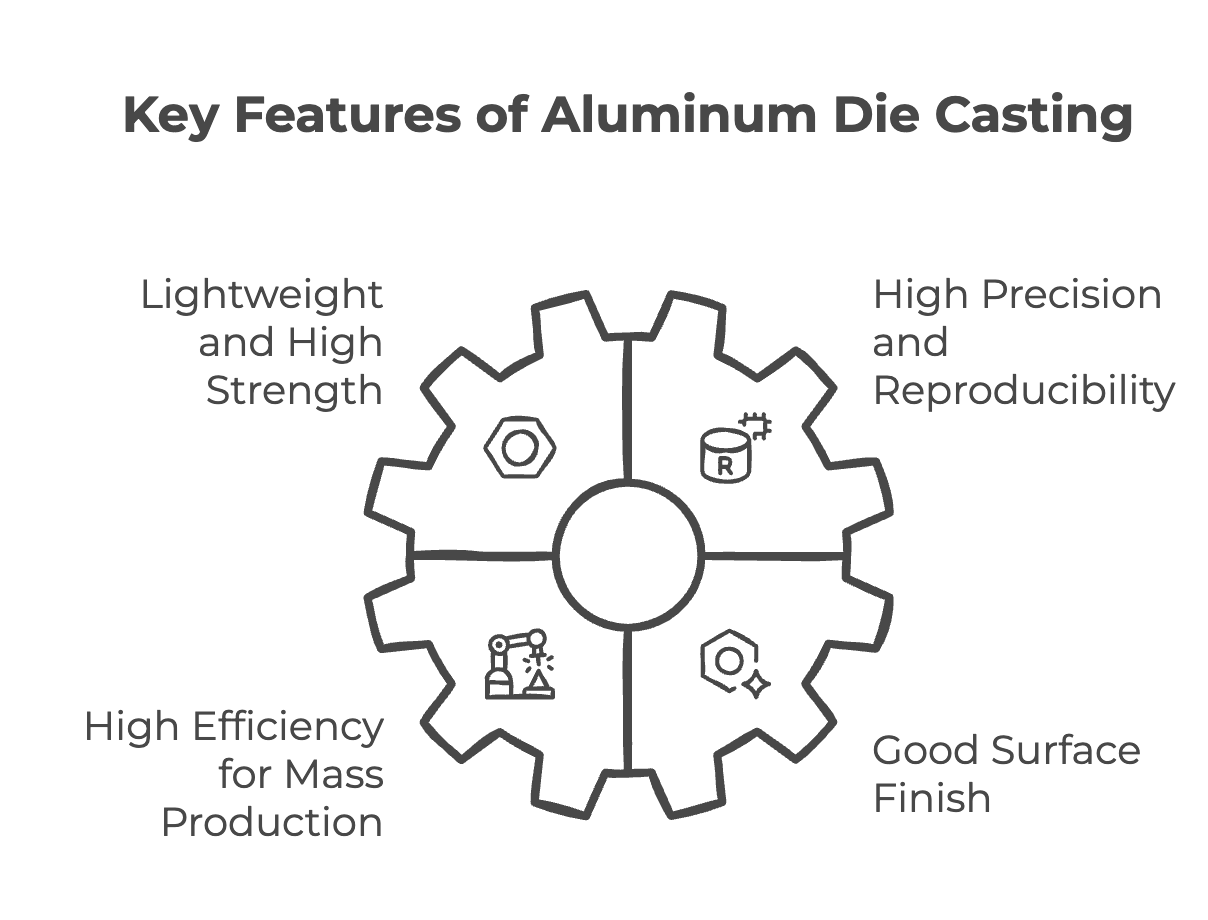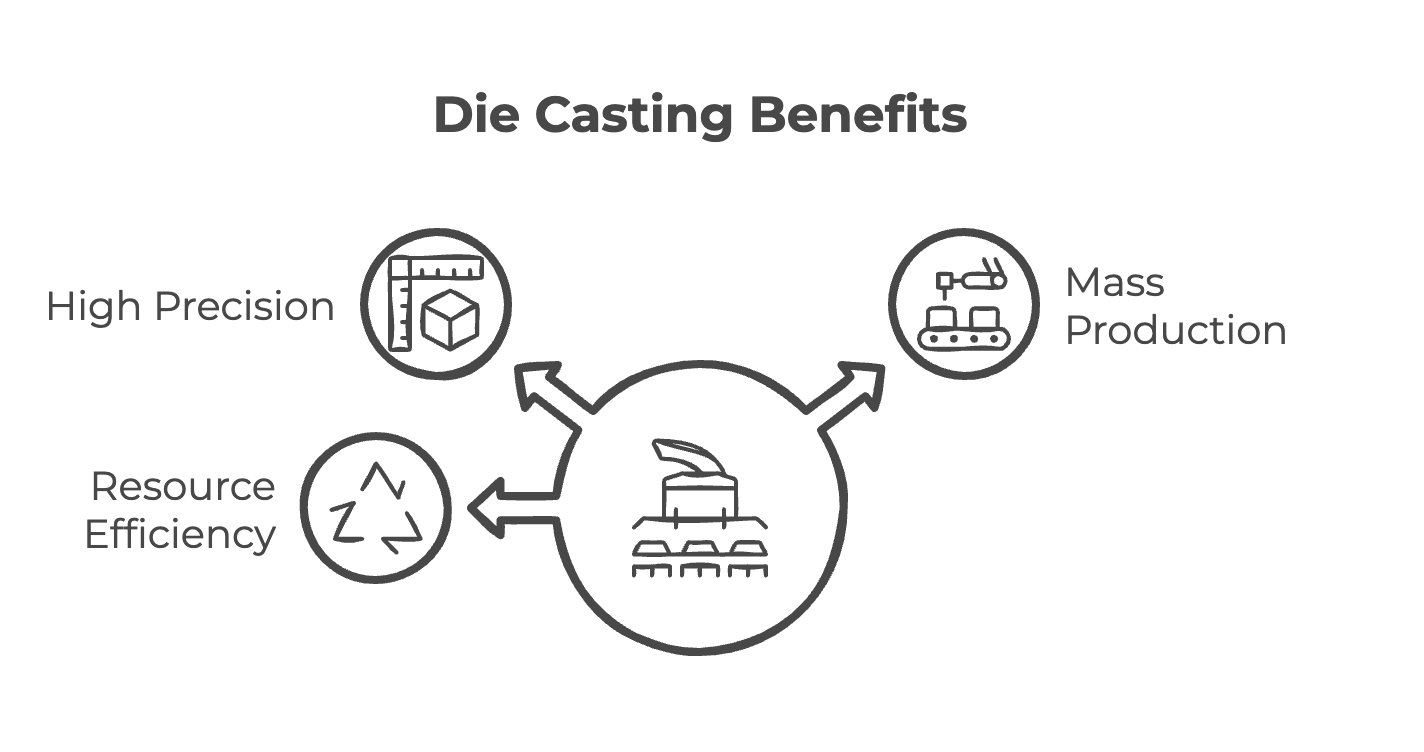◆Table of contents
ToggleIntroduction
Aluminum die casting is a casting technology suitable for high-precision and mass production. It is used in a wide range of fields such as automobiles, electronics, and industrial machinery because it can form parts with complex shapes with high precision in a short time.
In recent years, die casting technology has further evolved. More precise and high-quality parts manufacturing is now possible through uniform filling by high-pressure injection, high-precision mold technology, and optimization of cooling and solidification. In addition, the development of automation technology has improved production efficiency and reduced costs.
This article will explain in detail why aluminum die casting is optimal for high-precision and mass production. We will cover a wide range of topics from basic principles and advantages to application examples and the latest technologies, so please read to the end.
What is Die Casting?
Basic Principles of Die Casting
Die casting is a casting technology that injects molten metal into a mold at high pressure and forms it in a short time. Because it can efficiently produce precise shapes, it is widely used in various fields such as automobile parts, home appliances, and machine parts.
Unlike sand casting and lost wax casting, this technology is characterized by its ability to achieve high precision and high productivity. For more details, please see “What is Aluminum Die Casting? A Thorough Explanation of Features, Advantages, and Disadvantages“.
Characteristics of Aluminum Die Casting
Die casting using aluminum (aluminum die casting) is lightweight yet strong and has excellent corrosion resistance. It has the following characteristics in particular.
- Lightweight and High Strength: The characteristics of aluminum alloys enable weight reduction while maintaining strength.
- High Precision and Reproducibility of Complex Shapes: Because metal molds are used, even fine details can be faithfully reproduced.
- High Efficiency Suitable for Mass Production: Short-time production by injection molding is possible, contributing to cost reduction.
- Good Surface Finish: Die-cast products have a smooth casting skin and often do not require additional surface treatment.
For more information, please see Characteristics and Advantages of Aluminum Die Casting.
Reasons Why Die Casting is Suitable for High-Precision and Mass Production
Die casting is a casting technology that injects molten metal into a mold at high pressure and forms it in a short time. With the advancement of precision machining technology for molds and cooling control, it is widely adopted as a manufacturing method suitable for high-precision and mass production.
Elements That Achieve High Precision
Uniform filling by high-pressure injection
By injecting molten aluminum at high pressure, it is uniformly filled into every corner of the mold, and variations in wall thickness are suppressed. This ensures high dimensional accuracy even for complex shapes.
Improvement of mold accuracy
With the evolution of machine tools and CAD/CAM technology in recent years, precise mold machining in micron units has become possible. This minimizes post-casting machining and achieves high reproducibility.
Progress in cooling and solidification control technology
In the casting process, controlling the cooling rate is important. Optimal cooling design and improvements in the cooling circuit inside the mold minimize deformation and shrinkage during solidification. This enables improved dimensional stability and reduced internal defects.
Reasons Why It Is Optimal for Mass Production
Short molding cycle
Die casting completes molding in a few seconds to a dozen seconds per shot, enabling continuous production. This achieves overwhelmingly high production efficiency compared to other casting methods.
Improved mold life
In recent years, mold surface treatment technology (PVD coating, nitriding, etc.) has evolved, suppressing deterioration due to wear and thermal fatigue. This has improved mold life and enabled long-term mass production with stable quality.
Development of automation technology
Automation of the mold clamping and removal process by robot arms has progressed, achieving labor savings in manufacturing and improved production speed. In addition, automation of quality inspection and deburring has progressed, enabling stable quality control.
Reuse of scrap
In the die casting process, scrap such as runners and risers is generated, but material loss can be reduced by remelting and reusing these. As a result, this leads to cost reduction and improved resource efficiency.
In this way, die casting is a casting technology that can achieve both high precision and mass production, and is used in a wide range of fields such as automobile parts and electronic devices.
Applications of Aluminum Die Casting
Aluminum die casting is used in a wide range of fields, taking advantage of its lightweight, high precision, and high thermal conductivity. In recent years, with the development of EVs and 5G communication equipment, further expansion of demand is expected.
Automotive Industry
It is widely used in parts that require weight reduction, such as engine parts, transmission cases, and wheels. Especially in EVs (electric vehicles), it is also used for battery cases and motor housings, and replacement from iron and steel is progressing.
Electronics and Communication Equipment
It is used for heat sinks and electronic equipment housings that require heat dissipation. New applications such as 5G communication equipment and EV battery cases are increasing, and the strengths of die casting, which enables high-precision and thin-walled molding, are being demonstrated.
Industrial Machinery and Construction
Taking advantage of its light weight and high durability, it is also used for component parts of various industrial machinery and building materials. In particular, a new technology that rapidly produces die-cast products with complex shapes by utilizing molds manufactured by 3D printers is attracting attention.
In this way, aluminum die casting is used in various fields, and its applications are further expanding with technological innovation.
Future Technology Trends and Challenges
Aluminum die casting technology continues to evolve, aiming for further high performance and reduced environmental impact. With the development of high-strength, high-heat-resistant materials and the advancement of precision control technology, it is expected to overcome conventional challenges and expand into new markets.
Trends in Technological Innovation
- New high-strength and high-heat-resistant aluminum alloys
In the EV and aerospace fields, the development of alloys that can maintain strength even in high-temperature environments is progressing. Special alloys containing magnesium and silicon are attracting attention. - Thin-walled and lightweight die casting by precision control
Thinning and weight reduction are progressing due to the improvement of high-pressure casting technology and process control using AI. In particular, the development of thin-walled parts with a thickness of 1 mm or less is underway to meet the weight reduction needs of automobiles.
Challenges and Solutions
- High initial equipment investment
Die casting has a high hurdle for new entrants because of the high cost of mold manufacturing. However, efforts are underway to reduce the number of prototypes and reduce cost risks by developing flow analysis and simulation technology using CAE (computer-aided engineering). - Recycling and environmental measures
Die-cast products are highly recyclable, but reducing CO₂ emissions during manufacturing is a challenge. The adoption of low-carbon aluminum and the development of energy-saving casting technology are required. In particular, energy efficiency is being improved by introducing vacuum die casting and semi-solid casting.
Through technological innovation, aluminum die casting is undergoing further evolution, and the transition to a sustainable manufacturing process is accelerating.
Summary
Aluminum die casting is used in a wide range of fields such as automobiles, electronic devices, and industrial machinery as a high-precision and high-efficiency casting technology. It enables the manufacture of lightweight and complex-shaped parts due to its excellent dimensional accuracy and suitability for mass production by high-pressure casting.
In recent years, further high precision and durability improvements have been achieved through the development of new aluminum alloys and the evolution of process control technology. Also, from the viewpoint of reducing environmental impact, the introduction of recycling technology and low-energy manufacturing processes is accelerating.
With the advancement of technological innovation in the future, cost reduction and optimization of manufacturing processes are expected, and aluminum die casting will play an important role in more fields.


